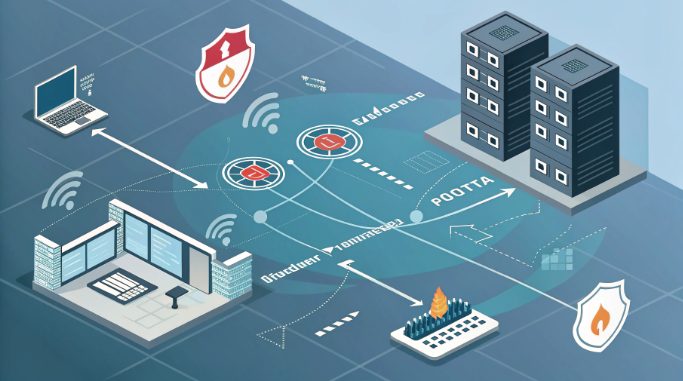High-Defense IPs: Expanding Bandwidth from Sudden Attacks

In today’s increasingly hostile cyber environment, managing DDoS protection bandwidth for high-defense IP addresses has become crucial for tech professionals. The escalating sophistication of cyber attacks, particularly in the Asia-Pacific region, demands robust protection mechanisms that can scale dynamically. This comprehensive guide explores advanced strategies for scaling protection bandwidth, with a special focus on Hong Kong hosting infrastructure and cutting-edge traffic attack mitigation techniques.
Understanding the Current Threat Landscape
The cybersecurity landscape in 2025 presents unprecedented challenges, with DDoS attacks reaching new levels of sophistication. According to recent statistics, the average DDoS attack size has increased by 300% compared to 2023, making traditional protection bandwidth limits increasingly inadequate. Modern attacks frequently combine multiple vectors, utilizing both network-layer floods and application-layer exploits to maximize their impact.
- Peak attack volumes exceeding 1.5 Tbps, with some incidents reaching 2.0 Tbps
- Multi-vector attacks combining volumetric, protocol, and application layer threats
- AI-powered attack patterns requiring adaptive defense mechanisms
- Increased frequency of IoT botnet-driven attacks
- Rising instances of ransom DDoS attacks targeting critical infrastructure
The evolution of attack methodologies has necessitated a fundamental shift in protection strategies. Traditional static bandwidth allocation no longer provides adequate defense against modern threats. Organizations must adopt dynamic, intelligent protection systems that can adapt to rapidly changing attack patterns.
Core Methods for Bandwidth Expansion
Implementing scalable bandwidth protection requires a sophisticated multi-layered approach that combines traditional methods with cutting-edge technologies:
- Elastic Protection Scaling
- Dynamic bandwidth adjustment based on real-time traffic analysis and machine learning predictions
- Automated scaling triggers with customizable thresholds and intelligent baseline monitoring
- Pay-as-you-grow model for cost optimization with burst handling capabilities
- Advanced traffic profiling using neural network algorithms
- Automatic provisioning of additional scrubbing capacity during attacks
- Multi-Layer Protection Integration
- BGP anycast implementation with automated route optimization
- Global CDN integration with strategically located scrubbing centers
- Cross-border protection coordination utilizing international backbone networks
- Layer 3/4 and Layer 7 protection synchronization
- Advanced SSL/TLS handling capabilities for encrypted attack mitigation
- Infrastructure Optimization
- High-capacity backbone connections with major carriers
- Distributed scrubbing center architecture
- Hardware acceleration for packet processing
- Smart traffic routing algorithms
Hong Kong Hosting Infrastructure Advantages
Hong Kong’s strategic position in global networking offers unique advantages for DDoS protection, making it an ideal location for implementing advanced protection systems:
- Direct connectivity to major Asian internet exchanges
- HKIX (Hong Kong Internet Exchange)
- Equinix HK
- BBIX Hong Kong
- Low-latency access to mainland China networks
- Direct peering with major Chinese ISPs
- Optimized cross-border routing
- Reduced packet loss through dedicated channels
- Advanced peering arrangements with international carriers
- Tier-1 carrier partnerships
- Redundant submarine cable connections
- Multiple terrestrial routes
Implementing Smart Protection Strategies
Advanced protection requires sophisticated traffic analysis and response mechanisms that leverage cutting-edge technologies. Modern DDoS protection systems must incorporate artificial intelligence and machine learning capabilities to effectively counter evolving threats:
- Machine Learning-Based Traffic Analysis
- Deep learning models for traffic pattern recognition
- TensorFlow-based anomaly detection
- Real-time traffic classification
- Predictive attack modeling
- Behavioral analysis of incoming traffic
- Protocol behavior profiling
- Source IP reputation scoring
- Connection pattern analysis
- Automated response calibration
- Dynamic rule generation
- Adaptive threshold adjustment
- False positive minimization
- Deep learning models for traffic pattern recognition
- Geographic Traffic Distribution
- Load balancing across multiple data centers
- Global server load balancing (GSLB)
- Anycast routing optimization
- Geographic-based traffic steering
- Regional traffic filtering
- Local scrubbing center deployment
- Region-specific rule sets
- Cross-regional coordination
- Load balancing across multiple data centers
Technical Implementation Considerations
Implementing expanded protection bandwidth requires careful attention to technical details and infrastructure requirements. Here’s a detailed breakdown of key considerations:
- Network Architecture Requirements
- Infrastructure scalability assessment
- Bandwidth capacity planning
- Hardware resource allocation
- Network topology optimization
- BGP routing optimization
- Route propagation efficiency
- AS path optimization
- Community tag implementation
- Infrastructure scalability assessment
- Monitoring and Analytics Setup
- Real-time traffic visualization
- Custom dashboard development
- Metric visualization tools
- Alert correlation systems
- Performance metrics tracking
- Latency monitoring
- Packet loss analysis
- Bandwidth utilization tracking
- Real-time traffic visualization
Cost-Effective Bandwidth Management
Optimizing the cost-effectiveness of expanded protection bandwidth requires a strategic approach to resource allocation:
- Dynamic resource allocation
- Auto-scaling thresholds configuration
- Peak usage optimization
- Resource utilization monitoring
- Cost optimization strategies
- Traffic pattern analysis for predictive scaling
- Multi-provider cost comparison
- Bandwidth commitment planning
Future-Proofing Your Protection Strategy
As cyber threats continue to evolve, organizations must maintain a forward-looking approach to DDoS protection:
- Emerging threat monitoring
- Threat intelligence integration
- Zero-day attack detection
- Attack trend analysis
- Protection bandwidth scalability planning
- Capacity forecasting
- Infrastructure upgrade planning
- Technology adoption roadmap
- Regular security audits and updates
- Protection effectiveness assessment
- Configuration optimization
- Security policy reviews
In conclusion, expanding DDoS protection bandwidth requires a comprehensive approach combining technical expertise, strategic planning, and advanced infrastructure utilization. By leveraging Hong Kong’s robust hosting environment and implementing sophisticated protection mechanisms, organizations can build resilient defense systems capable of handling modern cyber threats. The key to success lies in maintaining flexibility in protection strategies while ensuring cost-effectiveness and future scalability.

